|
FAQs about Marine Worms, Vermiform Animals
Identification 13
Related FAQs: Worm
IDs 1, Worm IDs 2, Worm IDs 3, Worm
IDs 4, Worm IDs 5, Worm IDs 6, Worm
IDs 7, Worm IDs 8, Worm IDs 9, Worm
IDs 10, Worm ID 11, Worm ID 12, Worm ID
14, Worm ID 15, Worm ID 16, Worm ID
17, Worm ID 18, See
Also: Flatworm ID 1 +,
Nemertean, Proboscis, Ribbon Worm ID
1, Nematode, Roundworm ID
1, Nematomorpha, Horsehair Worm ID
1, Acanthocephalans, Thorny-headed Worm ID
1, Tubeworm/Featherduster ID
1 +, Bristle Worm ID 1 +,
Hirudineans, Leech ID 1, Sipunculids, Peanut Worm ID 1, Echiuran Worm ID 1, Invertebrate Identification, Worms 1, Worms
2, Worms 3, Flatworms/Planaria, Fire/Bristleworms, FAQs on:
Worm Behavior, Worm Compatibility, Worm Selection, Worm
Systems, Worm Feeding, Worm Disease, Worm
Reproduction,
Related Articles: Worms,
Featherduster Worms,
|

|
|
Nudi/Worm ID? 10/6/08 Hello Everyone at WWM!
<Art> Yet again I find that I need some advice, or, at
least an ID of some sort... A few days ago I found this creature
crawling around my 55 Gallon Reef Tank. I looked up the worm FAQ
and had no luck. Whatever this thing is, it seems to be sensitive
to light. If I have the lights off and shine a light on it, it
quickly retracts into wherever it is anchored to. Another thing
is, I've never seen it in it's entirety. So it could be a
few inches long, or ...? The top of it has several
"openings" <"Polyplacophora"> I guess
you could call them, but I haven't been able to keep it in
the open long enough to see if they actually open. It's kinda
freaking me out. I was thinking a Nudibranch of some sort, but it
looks like nothing in your 6 or so Nudibranch ID pages. Please
help! I appreciate any info you can give me! -Art Perez <Is a
Chiton... not harmful. Please read here:
http://wetwebmedia.com/chitonidf.htm Bob Fenner>
|
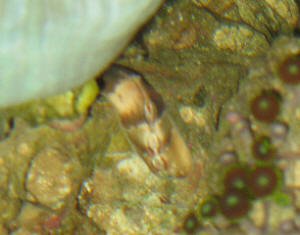
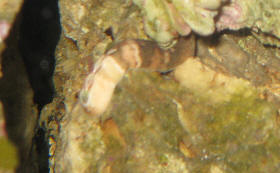 |
|
Worm or what? 10/1/08 This thing
is huge (silver dollar size), and I think it's moving
relatively fast. It looks to me like a giant flat worm. <To me
as well. Perhaps a Pseudoceros sp.> I guess it can't
reproduce and I guess it might be the reason I have not had luck
with shrimp in this tank and my serpent stars are being eaten
slowly. <Mmm, doubtful it is this Platyhelminth...>
That's a whole lot of guessing so maybe I'll just attach
a picture and see what the experts think. Thanks, As always love
this site, Jesse <Read here:
http://wetwebmedia.com/flatworms.htm the linked files above. Bob
Fenner>
|
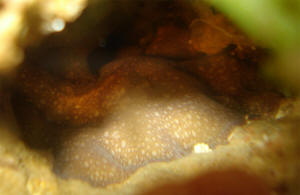 |
Question about unknown worm
-09/02/08 Hi. I've searched the entire internet by now
i think. I spent a couple of hours at least, and i haven't managed
to find an answer to my question. I found your page and hoped that you
could help. I went on a vacation to Greece this summer and one of the
days we had literally hundreds of these scary looking worms crawling
the rocky bottom of the harbour. The locals referred to them as
"Sea caterpillars" (translated from Greek). Some said they
were poisonous, others not. <They are what we in the aquarium hobby
call "Bristleworms"-- though this is a vague designation
given to any number of different species of similar looking scavenging
worms with stinging "bristles." The bristles can hurt you if
you handle touch them with your bare hands (depending on the worm, how
sensitive you are, and how much contact you have with it, the pain can
vary from intense to minor irritation).> I attached a picture of the
worm. What was this? I hoped you perhaps could email me the answer, or
at least tell me when and where the answer is posted. <Please see
here: http://www.wetwebmedia.com/polychaetes.htm> Thank you so much
for your help, I appreciate it! Regards Morten from Norway <Best,
Sara M.>
Unidentified.. um.. worm?
08/15/2008 Hi, we are having a very hard time figuring out what
this organism is in our 55-gal marine reef tank. I have spent hours on
your site searching, but it's hard to know even what to search for.
On one of the live rocks there was this spider web-looking flossy
strings (not legs) floating in the water off the rock. <Oooh, a
clue> Sometimes it would be there and sometimes it wouldn't be,
and different lengths from 0 to over 6". Then I saw its source
finally - something (maybe a worm of some kind?) <Likely so> that
is definitely a little living thing sort of chews or eats the floss
back in and then sends it back out, assumingly to catch more
"food." The thing is tiny, its "head" being about
2mm in diameter and is down in a hole in the rock, never comes out, so
I don't know how long it may be. It is dark in color, like black
and brown and seems to have a hairy head, but is very hard to see and
properly describe. Does this method of filter-feeding sound like any
animal you know of? If so, is it dangerous to anything (it doesn't
seem to be a threat to anything at all)? Thanks very very much. ~ C
& R <... see the Net, WWM re "spaghetti or Medusa
worms". Bob Fenner>
| What Is This Worm? A Nemertean! 7/28/08
<Hi there, Wendy.> Can you identify this animal? <Yes,
it's a beautiful little Nemertean (Phylum Nemertea, likely a
species in the genus Notospermus), aka a Ribbon worm. Please see
this link for more information/photos regarding:
http://www.wetwebmedia.com/ribnwrmidfaqs.htm> Fully stretched
out it was about 4-5' long (I tore it apart accidentally when I
pulled it out of the rock that it was in) <Woops!> Please
help. Thanks, Wendy <No worries, you should be good to go! Take
care, -Lynn> |
|
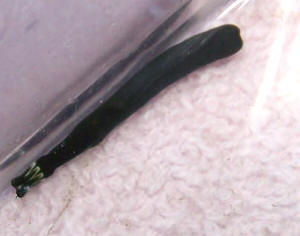
Re: What Is This Worm? A Nemertean! 7/28/08
<Hello again, Wendy!> Thank you so much for your help.
<You're very welcome.> I looked through this link it
seems that it will be okay to keep it in my tank. But I would
like to know what it eats. I have searched several areas and
can't seem to find what it eats. <Small invertebrates,
likely amphipods and such would be my guess. Nemerteans are
predators and scavengers, and although some varieties can get
very long indeed, the ones we usually run across (such as yours)
seem to cause no significant negative impact on the livestock
within the particular system.> Thanks again Wendy <It was
my pleasure. Take care, -Lynn>
|
|
What's in the tank? Hair or Spaghetti worm -- 7/16/08
Hello all! <Hi Kathy!> Once again I am in need of a
question answered... I have a 55 gallon saltwater tank. In
January I purchased 65lbs of live rock. For the last 7 months I
have been totally fascinated with the little creatures that are
emerging. <It's the gift that keeps on giving, isn't
it!> Yesterday I noticed what looked to me like long pieces of
hair on the bottom, across the crushed coral substrate. I have
long black hair so I thought some of it had gotten in the
tank...but when I looked closer it was thread-like, dark and
light alternating along the "thread" and it was
moving!! Then I notice 3 or 4 more! All seemed to be stretching
out from under a piece of the LR...and this morning when I fed
the fish, these "threads" seemed to attach to the blood
worms and mysis shrimp I had put in. They stretch out
approximately 6 to 8 inches... in different directions. I've
spent most of the morning reading and trying to identify, but I
can't wait. My eyes are blurry and I have to know,
"What's in my tank?" Can you give me a clue as to
what this is so that I can begin, in a logical place, to look on
the website, to research this little creature? <It sounds a
lot like a harmless/beneficial Hair worm/Cirratulid (Family
Cirratulidae), or possibly a Spaghetti worm/Terebellid (Family
Terebellidae). Both are deposit/detritus feeders, as well as
scavengers that make nice additions to a system. For more
information and photos, please see the following links:
http://forum.marinedepot.com/Topic34114-11-3.aspx (last post on
the page) See the Query 'Red worms with black Rings?
7/8/07' at this WWM link:
http://www.wetwebmedia.com/wormidfaq10.htm
http://www.reefkeeping.com/issues/2002-06/rs/index.php > OBTW
I love, love, love, your website! <Thank you, thank you, thank
you!> So much so that some days it's hard to do my
work...mind and body keep drifting back to the PC :) <Heheee!
I know the feeling!> Thanks so much, tootles, ~Kathy
<You're very welcome, Kathy. Take care, -Lynn>
Re: What's in the tank? Hair or Spaghetti worm --
7/17/08 <Hi Kathy> Well...creepy looking things.. but,
I will keep them around, the more I watch them the more
fascinating they are! <Indeed they are!> (I found a couple
more :) ) thanks again! Tootles, ~Kathy <It was a pleasure!
Take care, -Lynn>
|
| Unidentified worm 6/24/08 Hello
and thanks for your help in advance. I have a worm I found in my 46
gal. reef. It is 3/4 " long. It may be a Hawaiian feather
duster worm that lost its crown two days ago. <Yes> It was
stressed due to algae buildup I believe. This worm had a bite taken
out of it - it looks like. <Yes... this is some "middle
section"> My cherub angel has been hanging around the area
I found the worm. <Not from this... something larger> (I
found the worm in an oyster shell with a zoo colony). I also just
got two new frags at an exchange on Saturday. Briarium was closest
to the worm. The second picture is the underside of the worm. Any
ideas? Thanks so much! Adina <Is part of an Errantiate
Polychaete... see WWM, elsewhere re. Bob Fenner> |
|
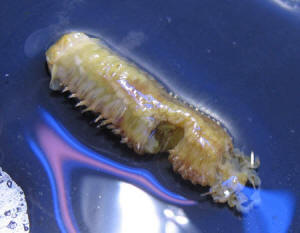
|
| Swimming Worm ID: Epitoke - 6/2/08 Hi Crew! <Hi
Jen!> Thanks for all of your help. <It's our
pleasure.> My nano reef seems to be coming along pretty well
thanks to you guys! <Yay!> Just an ID question for you today.
I was relaxing, having breakfast, staring at my tank calmly
enjoying my morning and admiring the new Xenia I brought home
yesterday... when all of a sudden this white THING comes shooting
up out of the rock and starts zipping around all over the tank.
<Heheeee! I had a run in with one of these a few years back.
It's a real eye opener, isn't it!> I mean clearly free
swimming and really fast. <Yep. It's a rapid and distinctive
shimmying/corkscrew motion that's interrupted with brief
periods of inactivity.> It's about an inch and a half long.
I got lucky and managed to catch it and take some pictures.
<Appreciate it!> On closer inspection it's clearly some
type of worm, <Yes, it's an errant Polychaete of some sort -
in a reproductive phase.> ..segmented and with two very
prominent eyes. It has two distinct sections, a sort of head/body
section and a sort of tail section. It swims with an eel like
motion, with the hair-like things rippling along the side of the
tail section. <Good observations! What you're seeing is a
harmless reproductive unit called an 'epitoke' or a
'swarmer'. Polychaetes reproduce in a number of ways, but
worms such as yours take it to a whole other level. They change
form, from what's originally a bottom dwelling/crawling animal
to a free-swimming version. One of these changes involves the
development of paddle-like structures, the 'hair-like
things' you mentioned on the posterior end of the Epitoke.
These enable the worm to swim up into the water column and spawn.
In some species, the gamete filled posterior segment detaches and
swims away on its own to spawn while the anterior/head section
returns to the reef and eventually regenerates. At any rate, these
epitokes rise up and gather in great numbers, perhaps in response
to a lunar or tide cycle, and on cue release their gametes (eggs
and sperm) into the currents.> I've attached photos for your
enjoyment (you can sort of see the swimming motion in the second
picture). Is this something to worry about? <Nope, not at all.
For more information, please Google the term 'epitoke' or
'epitoky' and see the FAQ's/photos at this link re:
http://www.wetwebmedia.com/wormidf11.htm Also, here are a couple of
photos of an Epitoke I had in my tank for comparison. It had a very
similar looking segmented posterior section and is in the Family
Nereididae. Size-wise, it was a little over 4.5' long.
http://wetwebfotos.com/usermedia/high/0/2470_44.jpg
http://wetwebfotos.com/usermedia/high/0/2470_46.jpg > Should I
put it back in the tank? <I wouldn't, not because it's
harmful, but because you have a nano and the Epitoke is already
out. The release of gametes and possible decay of the worm/section
of the worm would just add to the bioload.> I can't lie, it
scared the heck out of me and I definitely got the heebie jeebies!
<Well, if it makes you feel any better, I had my face all the
way up to the glass when I saw the one in my tank. I jumped back
and screamed like a little girl! :-D> Thanks again!!
<You're very welcome! Take care, -Lynn> |
|
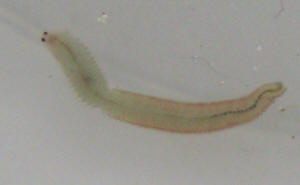
|
Please help me ID this hitchhiker
-Peanut worn ID 5/12/08 Hi Crew, Thank for all for this
great web site. I am learning all I can to correct all the newbie
mistakes I've committed. <cool> Please see the attached
photo. Can you identify this hitchhiker? <Yep... looks like a
peanut worm. Please see here:
http://www.wetwebmedia.com/pnutwrmidfaqs.htm> It actually looks
more like an eel than a worm. But it's too tiny (maybe 2 mm
diameter) to be anything other than a worm?! This is the second
time I've seen it out the live rock feeding. It's making a
darting motion but I can't tell what it is eating. My
tank is 14G BioCube with 2 Damsels (peacefully co-existing),
various hermit crabs and snails, and variously beginner polyps.
Thanks for your help! Evan
<De nada,
Sara M.> |
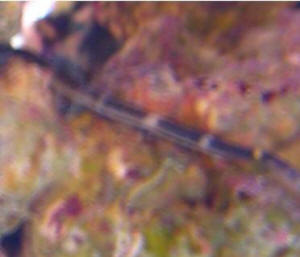 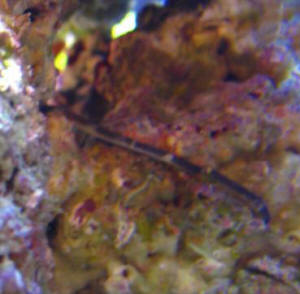 |
| Worm living in clam... Vermetid living on
Tridacnid 5/4/08 Hey guys, <Tom> First,
i <... I> just wanted to say i love this website. I use it to
research everything i see going on in my tank. It's always been
extremely helpful. Unfortunately, i couldn't find the answer to
this and am hoping someone can help. <I'll try> I just
purchased what i was told to be a Tridacna Clam a few hours ago.
<Is> When i got it home, about an hour after i placed the
clam in my tank, I noticed a worm coming out of the clam. <I
see... a Vermetid snail on the outside... end of the shell... is
this what you're referring to?> I read that there are worms
that can burrow it's way in, but the reason i thought this is a
different situation is that it looks as if the hole that it enters
is actually a hole that is part of the clam. It's as if
it's hole is a tunnel, and you can see it running down the
clam. In the picture, all you can see is the top of it's head
and antennae, everything below is actually part of the clam, not
the worm. Can someone help? Is this normal, is it a clam that
should quickly be quarantined and then returned to the LFS? Thank
you so much for your help!!! Tom. <Is a tubiculous snail... not
to worry... not destructive, deleterious... And even very
interesting... See the family name on the Net, WWM... Bob
Fenner> |
|

|
|
|

